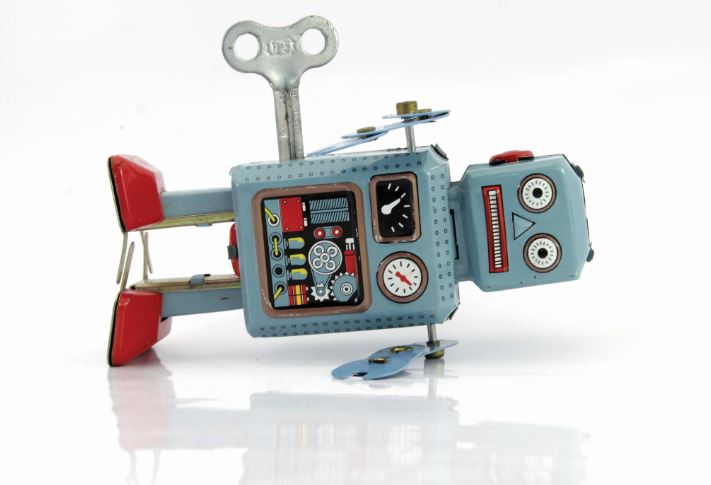 Elon Musk had a dream: a car factory that looked more “alien” than human, with hundreds of robots working cooperatively on the assembly line like a hyper-efficient hive. A handful of humans would oversee the work, but for the most part, the manufacturing of Tesla’s Model 3 electric vehicle would be fully automated. Robots can do everything people can do, Musk reasoned, but many, many times faster—so why not take the people, who are a drag on production speed, out of the equation? His stated goal: to achieve a 20-fold increase in production speed for Tesla’s Model 3 electric vehicle and be cranking out 20,000 cars per month by the end of 2017.
Elon Musk had a dream: a car factory that looked more “alien” than human, with hundreds of robots working cooperatively on the assembly line like a hyper-efficient hive. A handful of humans would oversee the work, but for the most part, the manufacturing of Tesla’s Model 3 electric vehicle would be fully automated. Robots can do everything people can do, Musk reasoned, but many, many times faster—so why not take the people, who are a drag on production speed, out of the equation? His stated goal: to achieve a 20-fold increase in production speed for Tesla’s Model 3 electric vehicle and be cranking out 20,000 cars per month by the end of 2017.
But a funny thing happened on the way to future: the robots weren’t quite up to the task. While Musk had promised production of 20,000 Model 3s per month by December, a mere 2,425 rolled off the line for all of the last three months of 2017, leading up to a record loss in Q1 2018 of $785 million. Ultimately, Musk had to reverse course, pulling his new robots off the lines and hiring hundreds of employees a week to rescue the Model 3 targets.
As Tesla continues to burn through its cash, the missed production targets have resulted in order cancelations, a falling share price and downgrades on both stock and debt. In July, Tesla claimed it had hit the 5,000-per-week production target, but a nervous Street seems not at all confident that the rate is sustainable.
Musk offered his mea culpa in a tweet: “Excessive automation at Tesla was a mistake. To be precise, my mistake. Humans are underrated.”
That’s hardly a surprise for most manufacturing CEOs. For all their promise, two decades of overblown hype and expensive false starts have clearly demonstrated that robots will not replace humans any time soon. In fact, a study of plant performance by the consulting firm Oliver Wyman actually found that the most automated factories ranked not at the top for productivity—but at the bottom.
“People are the most flexible form of automation you can have,” says Ron Harbour, a Wyman partner who has studied industrial automation for decades.
Tom Shoupe, COO of Honda of America Manufacturing, agrees. “It is our fundamental belief that humans are the most important element of our operation,” says Shoupe. While Honda uses advanced manufacturing technology, including sophisticated robotics, “we’ve taken the approach that we automate only where it’s appropriate, where there’s an efficiency issue, and then we allocate our people to something that requires more human touch. The touch, the feel, the senses of human beings can’t be replaced by machines.”
A Robot’s Role
It isn’t all hype, of course. Rapid advances in technology offer increasingly tantalizing opportunities. Robots and automation already play a prominent role in all parts of Industry 4.0, coming together with learning algorithms that allow both bots and humans to optimize production and improve quality. Increasingly sophisticated systems will be critical to addressing important elements of the skills gap, which, according to the most recent study by Deloitte and the Manufacturing Institute, will result in 2 million unfilled jobs by 2025. The hardest to fill will be those jobs that are dangerous, involve tedious repetition or are simply unpleasant. In other words, jobs that are perfect for robots.
“If we don’t automate, who is going to fill those positions? I’ll tell you—China will,” says Anthony Nighswander, CEO of Hicksville, Ohio-based APT Manufacturing Solutions, which helps other manufacturers automate their assembly lines. “Offshoring happened because there were jobs nobody wanted to do here, so China said, ‘We’ll take them.’ Why would we not want to take those back with robots?”
Many U.S. manufacturers likely would agree with that, having by now accepted that robots will play a prominent role in Industry 4.0. In this latest industrial revolution, and the era of the “smart factory” well under way, computers and automation are coming together in a new way: robotics are connected to computer systems that are equipped with artificial intelligence and learning algorithms that can allow both robots and humans to make fast decisions to optimize production and improve quality, all to the exacting specifications of a knowledgeable and demanding end user.
At the same time, CEOs who have been down this road will tell you that too much automation too soon can be the death knell of an otherwise successful manufacturer. As with the three industrial revolutions that came before this new digital age, change can’t happen overnight. “The context I like to keep in mind is when companies went from steam to electric, they tended to electrify the production line exactly as it had been set up in its steam configuration,” says Siemens U.S. CEO Barbara Humpton. “Then the groundbreakers said, ‘Wait, I can put equipment in any configuration I want because I don’thave to power it down a steam production line.’ But the thing we’re talking about a lot here at Siemens is, with each one of these changes, we’ve elevated the role of the human in the process.”

Chief Executive Group exists to improve the performance of U.S. CEOs, senior executives and public-company directors, helping you grow your companies, build your communities and strengthen society. Learn more at chiefexecutivegroup.com.
0

1:00 - 5:00 pm
Over 70% of Executives Surveyed Agree: Many Strategic Planning Efforts Lack Systematic Approach Tips for Enhancing Your Strategic Planning Process
Executives expressed frustration with their current strategic planning process. Issues include:
Steve Rutan and Denise Harrison have put together an afternoon workshop that will provide the tools you need to address these concerns. They have worked with hundreds of executives to develop a systematic approach that will enable your team to make better decisions during strategic planning. Steve and Denise will walk you through exercises for prioritizing your lists and steps that will reset and reinvigorate your process. This will be a hands-on workshop that will enable you to think about your business as you use the tools that are being presented. If you are ready for a Strategic Planning tune-up, select this workshop in your registration form. The additional fee of $695 will be added to your total.

2:00 - 5:00 pm
Female leaders face the same issues all leaders do, but they often face additional challenges too. In this peer session, we will facilitate a discussion of best practices and how to overcome common barriers to help women leaders be more effective within and outside their organizations.
Limited space available.

10:30 - 5:00 pm
General’s Retreat at Hermitage Golf Course
Sponsored by UBS
General’s Retreat, built in 1986 with architect Gary Roger Baird, has been voted the “Best Golf Course in Nashville” and is a “must play” when visiting the Nashville, Tennessee area. With the beautiful setting along the Cumberland River, golfers of all capabilities will thoroughly enjoy the golf, scenery and hospitality.
The golf outing fee includes transportation to and from the hotel, greens/cart fees, use of practice facilities, and boxed lunch. The bus will leave the hotel at 10:30 am for a noon shotgun start and return to the hotel after the cocktail reception following the completion of the round.